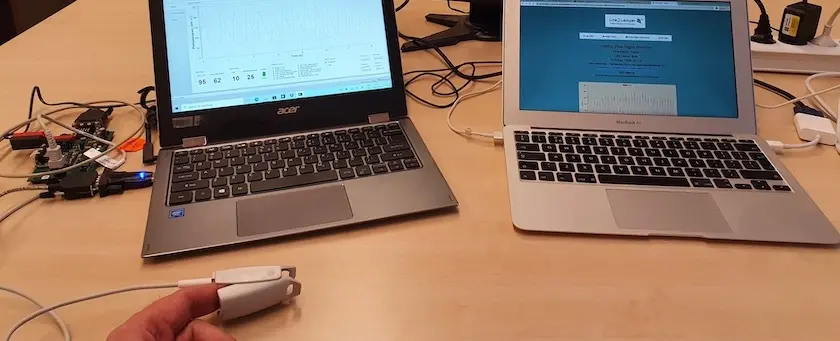The Patent Battle Between Apple and Masimo to Measure Blood Oxygen Levels with a Smartwatch
The potential infringement of Apple on a Masimo patent claiming that the patented technology is used in Apple Watches without permission

Protecting your inventions and innovations is crucial in a competitive market, and patents play a significant role in this. A patent provides protection against unauthorized activities such as producing, using, storing, and selling a product, technology, or method without the permission of the patent holder. This is referred to as patent infringement, constituting a violation of Intellectual Property (IP) rights, and such infringement is considered an illegal act.
If, as a patent owner, you believe there's infringement on your patent, you have the right to take legal action against the party doing so. These types of conflicts can have significant consequences, not only for the involved individual companies but also for the global innovation and technology climate.
An exemplary case is the longstanding dispute between Apple and the medical technology company, Masimo, concerning Apple's potential infringement of Masimo's patent, claiming that Apple used the patented technology in Apple Watches without permission. A recent court ruling found Apple indeed violated Masimo's patent, starting with the Apple Watch Series 6 and continuing into later versions of Apple Smart Watches. In response, Masimo is seeking a U.S. import ban on all current Apple Watches, which would cease the sale of these devices in the U.S. if granted.
The conflict between the two companies began in 2013 when Apple allegedly contacted Masimo for a potential collaboration. However, Masimo claims Apple used subsequent meetings to identify staff for recruitment. Over the years, Apple did hire several Masimo employees, raising concerns at Masimo about potential misappropriation of trade secrets.
However it may be, Apple has by now adapted two smartwatches (the recent models Apple Watch Series 9 and Apple Watch Ultra 2) and has asked the competent American International Trade Commission (the ITC, which focuses on investigating matters related to international trade and trade barriers) to take another look at the two models. If the commission concludes that the devices no longer use Masimo's patented technology, Apple is allowed to continue importing the smartwatches (as they are made in Southeast Asia). The ITC is expected to deliver its verdict on January 12.
Masimo is much smaller than Apple (the world's largest company) and claims to have already spent over $100 million on the conflict. Joe Kiani, Masimo's Chief Executive Officer, said the ruling "sends a powerful message that even the largest company in the world is not above the law." Masimo describes itself as a pioneer in modern pulse oximeters widely used in many hospitals. You might be familiar with them; see the photo above when we were testing our blockchain technology for healthcare using such an oxygen saturation meter ourselves. In 2020, Masimo sued Apple for trade secret theft and violation of 10 patents. In response, Apple claimed that Masimo's own W1 Advanced Health Tracking Watch violates multiple Apple patents.
But why are these companies engaging in such a major battle using their patents? Although pulse oximetry is an old technology used in hospitals, eliminating the need for external sensors was a crucial development for oxygen functionality in Apple Watch models. Both companies consider this essential and escalate the conflict because the (future) market for such wearable technologies is expected to be enormous. The focus is currently on being able to measure so-called vital signs, providing an initial indication of someone's medical well-being, such as body temperature, heart rate, blood pressure, blood oxygen saturation, and respiratory rate. But efforts are also underway to record an ECG or continuously monitor blood glucose levels in diabetic patients, eliminating the need for pricking.
It is expected that such smartwatches, capable of measuring these vital signs anywhere, will play a significant role in monitoring a person's health without the need for a physician, automatically forwarding this data from the smartwatch to, for instance, a medical post or hospital. The watch might warn his owner, "You may not know it yet, but put your coat on because the ambulance is on its way...". This joke illustrates that we're not there yet, but such technology is expected to be crucial in this development toward a vast market, and that's why many companies are trying to secure a robust position. Additionally, in the background, the increasingly expensive healthcare, diminishing healthcare staff, and available technology will surely be used. It also saves a lot of time and money, avoiding costly trips to and from a hospital or medical post just to see a doctor. Thus, it's also sustainable.
The changing landscape of healthcare
This is the broader transformation happening behind the scenes, against which the battle between Apple and Masimo is unfolding. Until now, hospital care has been primarily organized within the walls of a hospital. The doctor, diagnostic laboratory, and the computers containing the patient's records are all located within the hospital. The patient comes to the hospital, consults with the doctor, leaves, and often returns later for further examinations and/or follow-up discussions.
However, this is changing globally and at an accelerating pace. Driven by scarcity, technology, and, of course, expedited by Covid-19, healthcare is shifting. Increasingly, healthcare activities are taking place outside the confines of traditional institutions. The technology used in this transformation is familiar to all of you: sensors, various medical devices for home use, cloud solutions, AI, and platforms for data exchange. This integrated network of technology and healthcare within and beyond institutions is referred to as distributed care, and it is anticipated that there is significant potential for profit, even for companies not previously widely involved in healthcare, such as Apple.
This battle is interesting for other reasons as well. The impending import ban on the Apple Watch has sparked reactions from various quarters, emphasizing the importance of innovation and intellectual property. It's not good for the global innovation climate when the very large companies just take what they want without adhering to the rules. Therefore, the legal dispute raises questions about the responsibility of major tech companies like Apple in potential patent infringements and intellectual property. Although the definitive impact is uncertain, this case is expected to continue leading to robust legal and political discussions. However, the case is still evolving, and the final outcome remains uncertain. We should know more by April 12.
UPDATE of January 16, 2024: It seems that Masimo is now (temporarily) the winning party. The American ITC has ruled on April 12 that Apple still infringes on Masimo's patents. And now, according to the tech site Macrumors, there are rumors that Apple is giving up on the oxygen saturation feature on both Smartwatches. That means, the feature is still on board, but simply turned off. Of course, this also means that the oxygen saturation meter can potentially be turned on again. Because Apple intends to release a software update that allows the saturation meter to be used without infringing on Masimo's patents. Whether this will succeed is not yet certain, and Masimo has previously stated that they want the feature to completely disappear from the Apple Smart Watches. So this battle will undoubtedly have a sequel.
UPDATE of September 12, 2024: Recently, at Apple's big event of the year, where the iPhone 16 was presented, the absence of the blood oxygen feature on U.S. versions of the Series 10 Apple Watch raised eyebrows. Introduced with the Series 6, this feature has been a key health component for Apple's wearable devices. However, while the rest of the world will continue to have access to this functionality on the new models, it won't be available in the U.S., likely due to Apple's ongoing patent battle with medical device company Masimo. This ongoing legal dispute led to the feature being disabled on the Series 9 and Ultra 2 models last year. Apple hasn't clarified whether the blood oxygen sensor's removal on the Series 10 is due to a hardware change or if it's just a software block, as seen with the Series 9. More details may emerge after the Series 10 hits the market and teardown experts examine the device. If it's a hardware issue, Apple may have designed slightly different models for different regions. Apple has been contesting Masimo's patent lawsuit for some time. Earlier this year, a U.S. court reinstated a sales ban on Apple devices with the blood oxygen feature. In response, Apple has sought similar restrictions on Masimo's Freedom health watch. As you can read above, this money-consuming and seemingly pointless battle between Apple and Masimo has to do with taking a strategic position in the emerging integrated huge market of technology and healthcare: distributed healthcare.
UPDATE of March 25, 2025: At the end of 2023 and into early 2024, Apple faced a temporary U.S. sales ban on its Apple Watch Series 9 and Apple Watch Ultra 2 due to a patent dispute with Masimo over blood oxygen sensor technology. To resume sales, Apple was forced to disable certain functionalities to comply with the ruling. This is not the only case that shows taht Apple is fighting hard to get a dominant position in the health care sector. A similar threat emerged from AliveCor, which accused Apple of infringing patents related to heart-rate monitoring. However, after a prolonged legal battle, the U.S. Court of Appeals ruled in Apple's favor, upholding an earlier decision that invalidated AliveCor's patents. According to the court, the patents were too generic or obvious to enforce and failed to meet the three core requirements for patentability: novelty, inventive step (non-obviousness), and industrial applicability. You can read more about these criteria on our page about how to get a patent. Apple welcomed the outcome, reaffirming its commitment to innovation in health technology. AliveCor, on the other hand, voiced disappointment, arguing that the decision undermines the position of smaller innovators facing corporate giants. The company stated it would explore additional legal avenues. This case underscores Apple's aggressive drive to dominate the health tech sector. The company clearly recognizes the vast potential in this space and is prepared to invest heavily—both legally and technologically—to secure and maintain its leadership.
UPDATE of June 2, 2025: Apple seems to have introduced a strategic pause in Masimo patent dispute
Since late 2023, Apple has been involved in a legal dispute with medical technology company Masimo over the blood oxygen sensor in its Apple Watch. Following a ruling by the U.S. International Trade Commission (ITC), which found Apple in violation of Masimo's patents, Apple was forced to halt sales of its Series 9 and Ultra 2 watches in the U.S. temporarily. To comply, Apple disabled the blood oxygen feature on affected models for the U.S. market, though the functionality remains available in other regions.
Rather than settling quickly, Apple appears to be employing a strategic pause—temporarily disabling features while awaiting the outcome of its legal appeal. By disabling the contested feature, Apple can continue selling its devices while appealing the ITC decision. This approach allows the company to buy time—possibly awaiting favorable legal outcomes or exploring technological workarounds that circumvent the disputed patents.
Meanwhile, Apple continues to invest heavily in health-related innovation. The upcoming Apple Watch Series 11, expected in September 2025, is rumored to introduce new capabilities such as blood pressure monitoring and upgraded sensor technology. However, it remains uncertain whether the blood oxygen feature will be re-enabled in the U.S. models, pending the outcome of ongoing legal proceedings.
This case underscores the tension between rapid innovation and intellectual property enforcement. Apple’s strategy shows how tech giants may navigate legal obstacles not only through courtroom battles, but also through calculated commercial decisions—sacrificing features temporarily to protect market access and long-term dominance in health tech.
